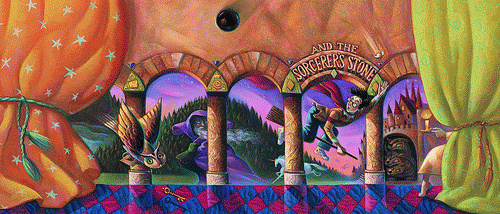We Didn’t Need the Americanized Versions of the “Harry Potter” Books
If you’re the kind of person (like me) who reads Harry Potter over and over, there’s a good chance that you’ve come across both the British and American versions of the books or audiobooks. You’ve probably noticed that there’s a difference – if only that, in the UK and Canada, the title of the first book is Harry Potter and the Philosopher’s Stone while it’s Harry Potter and the Sorcerer’s Stone in the US. While it’s not uncommon for publishers to redesign covers, titles, and even “translate” the books from one English-speaking nation to the next, I don’t think it’s a practice that’s generally necessary, and I especially don’t think they should have done it for the Harry Potter books.
So what are the main differences? There are obvious changes – like the title of the first book – but mostly the changes are cultural. Words for items and brands are changed to reflect familiar names for their audience. For example, “Sellotape” in the British version is changed to “Scotch tape” in the American version. This particular example emphasizes the disconnect between American colloquialisms and the world J.K. Rowling built as she plays off Muggle Sellotape with the wizarding equivalent Spellotape, which ends up getting lost on US readers.
A lot of other changes are related to food – changing pudding to dessert, kippers to sausages, sherbet lemon to lemon drops – or things like trainers becoming sneakers. None of these have much of an effect on the plot, but they do impact what we’re consuming when we read the books and add subtle changes to the cultural world of Harry Potter.
While it’s not hard to see why these changes were made – marketability and appealing to the readers in the geographic areas that they’re being sold – I think that it does a disservice to those readers and shows a lack of trust in their ability to understand and identify with an experience different from their own.
Reading takes us to another world whether it’s somewhere fictional, like the wizarding world, or just to a fictionalized version of the one we live in. Part of immersing ourselves in that world is soaking up the culture that’s represented there, feeling like we get to live inside it for a time. At the heart of it all, Harry Potter is set in Britain. Harry, Ron, and Hermione are British kids, and Hogwarts is very much set in the UK. When J.K. Rowling expanded the wizarding world by introducing Beauxbatons, Durmstrang, and later Ilvermorny, she showed us how different cultures experience magic and the vibrant community of wizards and witches all over the world.
The other funny thing about feeling the need to adapt the Britishisms from the books for an American audience is that Muggle readers are already being thrown into a world that’s foreign to them in the form of the wizarding world. We’re easily able to take things like butterbeer, Hippogriffs, and Quidditch in stride, to enjoy the ways in which they differentiate from our own experiences and the Muggle world. If that’s the case, then surely we can also learn to understand that pudding means dessert and not just a gelatinous custard treat, that chucking something in the bin is the same as throwing it in the garbage. By making all these small but significant changes to the language of the books, the publishers not only chipped away at the culture of the world inside them but cheapened the reader’s experience of that world.
So sure, there are reasons behind adapting books for an American market, most of them to do with money and marketing and not with the book itself. But the truth is, we don’t need them now, and we didn’t need them then.






